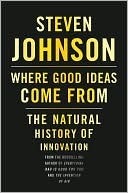More on this book
Community
Kindle Notes & Highlights
How Buildings Learn,
Two decades ago, the psychologist Mihaly Csikszentmihalyi proposed the concept of “flow” to describe the internal state of energized focus that characterizes the mind at its most productive. It’s a lovely metaphor, precisely because it suggests the essential fluidity that good ideas so often need. Flow is not the singular intensity of focusing “like a laser,” as we often say. And it is not the miraculous illumination of a sudden brainstorm. Rather, it is more the feeling of drifting along a stream, being carried in a clear direction, but still tossed in surprising ways by the eddies and whirls
...more
John Locke first began maintaining a commonplace book in 1652, during his first year at Oxford. Over the next decade he developed and refined an elaborate system for indexing the book’s content. Locke thought his method important enough that he appended it to a printing of his canonical work, An Essay Concerning Human Understanding. Locke’s approach seems almost comical in its intricacy, but it was a response to a specific set of design constraints: creating a functional index in only two pages that could be expanded as the commonplace book accumulated more quotes and observations:
“Bell’s Common-Place Book,
You need a system for capturing hunches, but not necessarily categorizing them, because categories can build barriers between disparate ideas, restrict them to their own conceptual islands. This is one way in which the human history of innovation deviates from the natural history. New ideas do not thrive on archipelagos.
Fritz Desir liked this
time” program for all Google engineers: for every four hours they spend working on official company projects, the engineers are required to spend one hour on their own pet project, guided entirely by their own passions and instincts.
“Innovation Time Off.”)
DEVONthink,
The secret to organizational inspiration is to build information networks that allow hunches to persist and disperse and recombine. Instead of cloistering your hunches in brainstorm sessions or R&D labs, create an environment where brainstorming is something that is constantly running in the background, throughout the organization, a collective version of the 20-percent-time concept that proved so successful for Google and 3M.
Fritz Desir liked this
Old ideas can sometimes use new buildings. New ideas must use old buildings.
The Calera story is still very much in progress. It remains an open question whether the cities of our future will be built underwater by virtual coral reefs on a diet of factory exhaust. It sounds fanciful when described that way, of course, but no more fanciful than the idea of the Great Barrier Reef would have seemed a billion years ago. Nature has long built its platforms by recycling the available resources, including the waste generated by other organisms. Two things we have in abundance on this planet right now are pollution and seawater. Why not try to build a city out of them?
The songbird doesn’t carry the cost of drilling and felling because the knowledge of how to do those things was openly supplied by other species in the chain. She just needs to know how to tweet.
In 1902, the Sackett-Wilhelm company had a profitable and growing business printing color publications, like the popular humor magazine Judge. But they faced one vexing problem: the air. Small changes in humidity could complicate the printing process on multiple levels: the paper would expand as it absorbed water molecules floating in the factory air; ink would flow at different rates, and dry more slowly. Unusually humid days could slow the entire production down dramatically, making it difficult for the Sackett-Wilhelm executives to promise reliable delivery times to its clients. Human
...more
it was far more difficult to create the kind of liquid network


